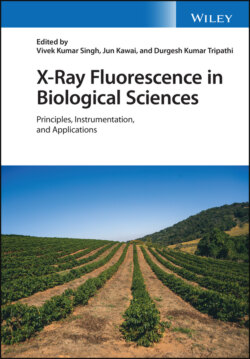Читать книгу X-Ray Fluorescence in Biological Sciences - Группа авторов - Страница 72
5.6 The Advantage of Using μ‐XRF and XAS to Explore the Interaction Mechanism Between Micro‐organisms and Heavy Metals
ОглавлениеXRF and XRS analysis techniques have obvious advantages in the analysis of environmental biological samples, especially in microbial samples. Most analysis methods require pretreatment the sample to create a uniform composition. They then detect the average concentration of elements. Heavy metals in biological samples are usually unevenly distributed. Determination of the distribution characteristics of heavy metal elements in a tissue or cell can help to understand the interaction mechanism between micro‐organisms and heavy metals. Synchrotron radiation‐XRF analysis has spatial resolution, and it can be used to analyze biological samples at the micron or even nano scale, which can be applied to investigate the distribution of heavy metal elements in the samples at the cellular level. With the development of third‐generation synchrotron radiation technology, micro‐beam X‐ray fluorescence spectroscopy (μ‐XRF), combined with micro‐beam X‐ray absorption structure (μ‐XANES) analysis technology make it possible to investigate the distribution characteristics and chemical species in a microbial cell. In addition, XAS can be used for the determination of amorphous materials, including solid, liquid, and even gas samples requiring no pretreatment.
The combination of μ‐XRF, STXM, and XANES methods are used for the in‐situ measurements of the distribution and morphological characteristics of heavy metals in the cells, which is an important means of exploring the microbial detoxification mechanism. High‐energy XRF with a spatial resolution of 150 nm was used to make elemental maps and qualitative chemical analyses of individual Pseudomonas fluorescens of planktonic and attached cells exposed to Cr(VI), and found that: (i) a large amount of the toxic element Cr is enriched in planktonic cells; (ii) notable excesses of Ca and P were found in attached cells, and Cr does not increase significantly in the cell, but is enriched within the 1–3 μm of surface‐adherent outside the cell; (iii) μ‐XANES analysis showed that Cr6+ was reduced to Cr3+ and associated with a phosphoryl functional group, which prevented Cr from entering into attached cells [26]. Researchers used XRF and XANES technology to investigate the distribution and chemical species status of heavy metals in C. metallidurans cells exposed to Au and Pt solutions, and found that gold was unevenly distributed in single cells, while Pt was evenly distributed. C. metallidurans cells accumulated less Pt, while more Au was absorbed in the center of the cell as nanoparticles, indicating that Pt had fewer toxic effects on cells than Au [27]. Reith et al. [19] combined XRF, TEM‐EDXA and XANE with a spot size of 120 × 150 nm to monitor the distribution of Au in C. metallidurans cells after being exposed to HAuCl4 for a different duration, and they found that the Au in the cell increased and then decreased after 144 hours of exposure. XANE results show that cellular Au formed Au(I)‐S compounds and finally produced Au nanoparticles. C. metallidurans reduced Au(III) to intra‐ and extracellular Au(0) and eliminated Au outside the cells [19]. Research on the detoxification mechanism of Penicillium oxalicum SL2 to Cr(VI) showed that when cells secreted cysteine and oxalic acid, Cr(VI) was reduced to chromium oxalate coupled to the formation of Cr(III)‐Cys intermediate complexes. Cr(VI) distributed in the hyphae and cytoplasm, indicating that Cr(VI) could translocate across the cell wall and cytomembrane into the hyphae, and Cr(VI) and Cr(III) had the same distribution characteristics in the hyphae.
XANES can be used to determine the chemical speciation in a specified area of samples that is preserved in its native state without pretreatment, which makes the results more authentic and reliable. Zeng et al. [28] used HPLC‐HG‐AFS and in‐situ XANES technology to analyze the species transformation of As(III) in Trichoderma asperellum, Penicillium janthinellum, and Fusarium oxysporum, and did not find methylated As in the cells of fungi using HPLC–HG–AFS, while MMA or/and DMA were observed using the XANES method. This may be due to the fact that for HPLC–HG–AFS analysis, mixed cellular samples must be acquired in advance via cellular lysis and centrifugation, which may change the chemical species of arsenic during pretreatment process. Thus, XANES can be applied directly to analyze the chemical species of samples in‐situ without pretreatment and the data obtained will be more reliable.
Acknowledgment
Authors thank Department of Biotechnology (No. BT/RLF/Re‐entry/32/2017),Government of India for funding this project.
